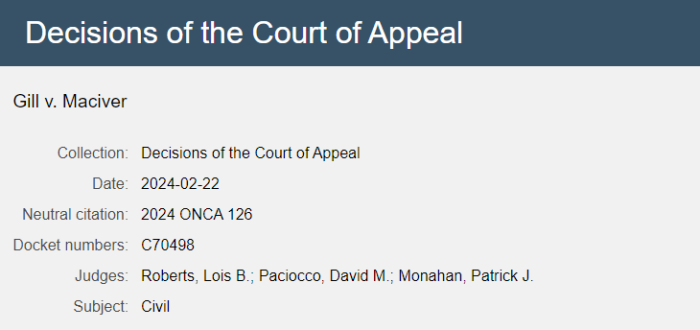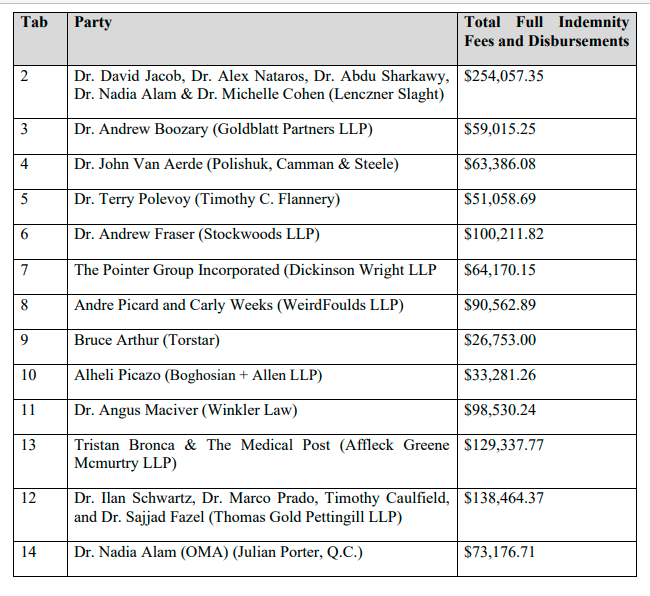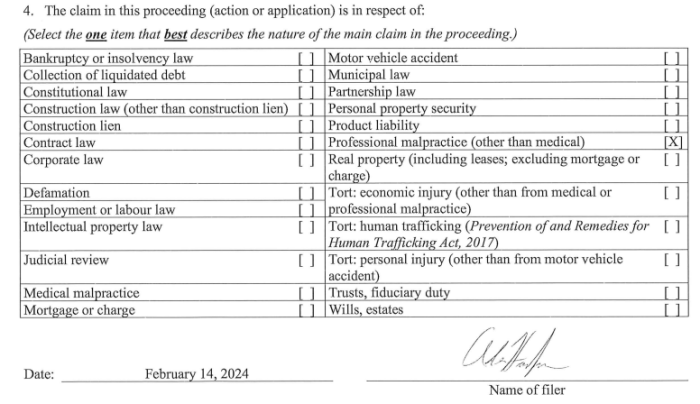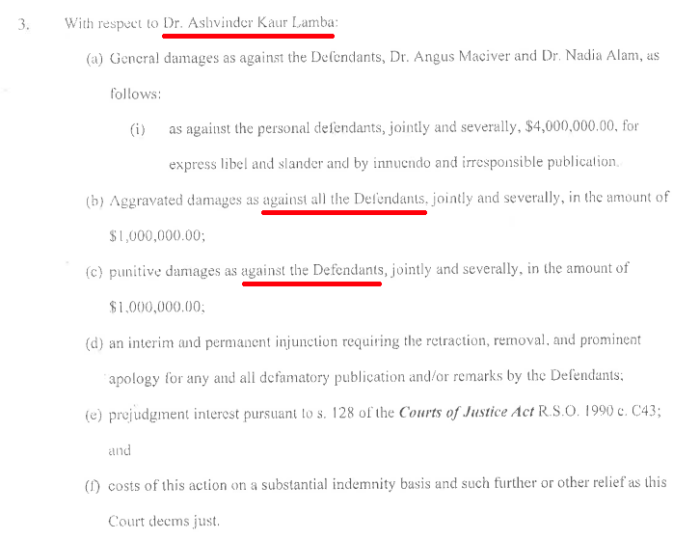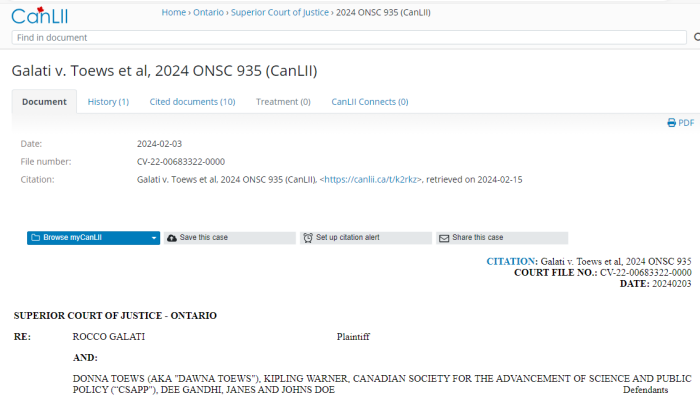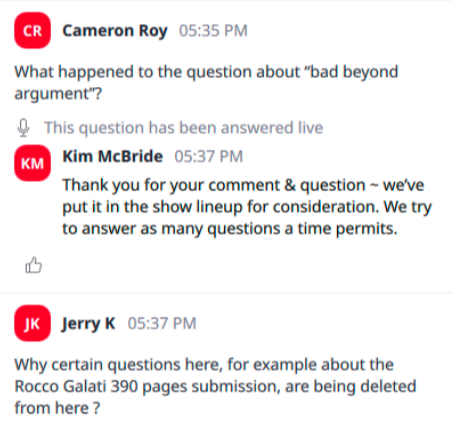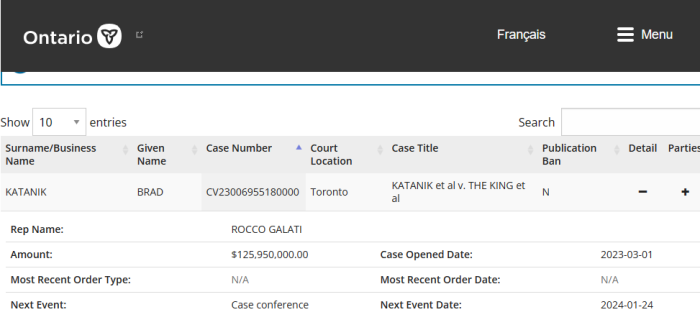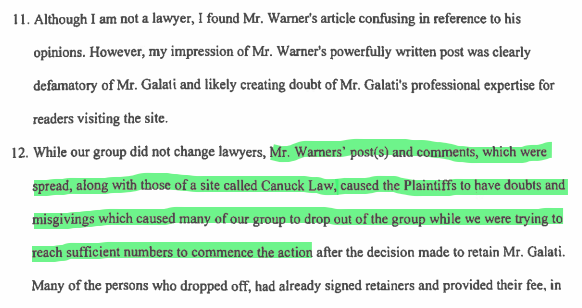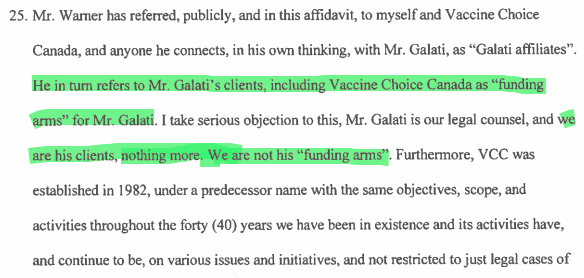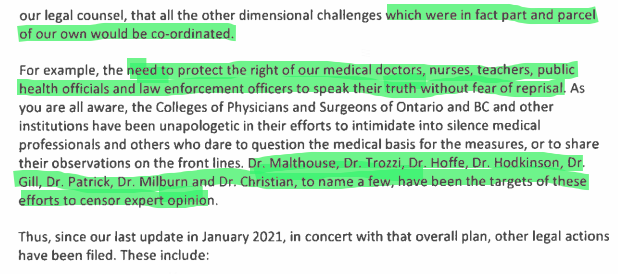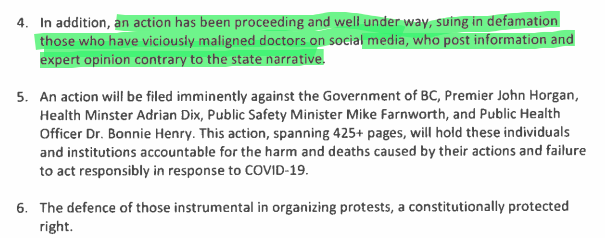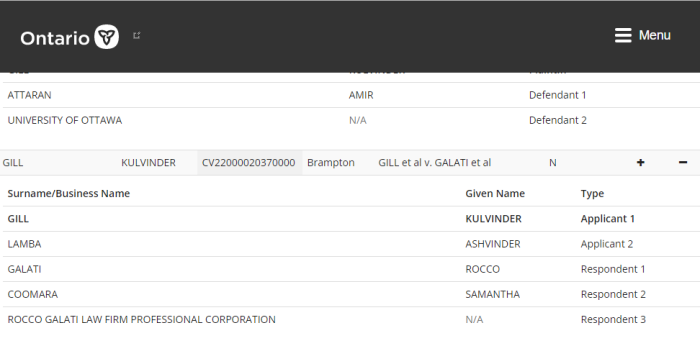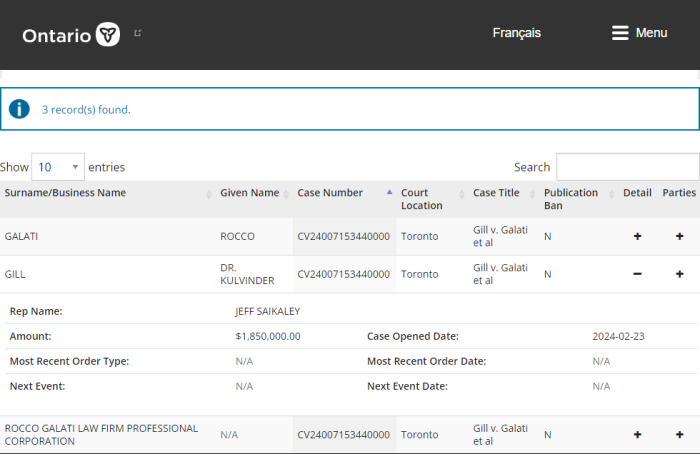
Last Friday, a Notice of Action was filed with the Ontario Superior Court, at their Toronto Division. A woman intends to sue her former counsel, “Mr. Bad Beyond Argument”, for: (a) professional negligence; (b) breach of fiduciary duty and/or breach of contract in the amount; and (c) aggravated and/or punitive damages.
A Notice of Action is not the same thing as a Statement of Claim. Instead, this document is occasionally filed when a lawsuit is in the works, but the Statute of Limitations is approaching. Justice Stewart dismissed the Gill/Lamba suit on February 24, 2022, and this Notice was filed February 23, 2024. This came just a day before the 2 year anniversary.
Once filed, a Plaintiff has 30 days under Rule 14.03 to serve all Defendants with this Notice, and the Claim itself. (Pardon the error which previously listed the time as 6 months).
Jeff Saikaley and Albert Brunet are listed as counsel for Kulvinder Gill. They also represented her at the Court of Appeal which ultimately dismissed the Maciver anti-SLAPP Appeal.
1. The Plaintiff, Dr. Kulvinder Gill, claims against the Defendants, Rocco Galati and Rocco Galati Law Firm Professional Corporation as follows:
a. General and special damages for professional negligence, breach of fiduciary duty and/or breach of contract in the amount of $1,500,000;
b. General damages for pain, suffering and loss of reputation in the amount of $250,000;
c. Aggravated and/or punitive damages in the amount of $100,000;
d. Prejudgment and postjudgment interest in accordance with sections 128 and 129 of the Courts of Justice Act, R.S.O. 1990, c. C.43, as amended;
e. The costs of this proceeding on a substantial indemnity basis, plus all applicable taxes, and;
f. Such further and other relief as the plaintiff may advise and as this Honourable Court
may seem just.
2. The Defendants acted for the Plaintiff with respect to various litigation matters starting in late 2020, including defamation actions and disciplinary proceedings initiated by the College of Physicians and Surgeons of Ontario. Their representation of the Plaintiff was negligent, constituted a breach of contract and a breach of the fiduciary duties, causing the Plaintiff significant damages.
Of course, this isn’t the entire pleading. The real Statement of Claim is presumably in the works, and it should be interesting to read. Ashvinder Lamba also has a $600,000 malpractice suit pending, alleging many of the same things as Gill.
Pre-2020: Gill and Lamba have prior issues with Maciver and Alam. These predate the “pandemic” and the debate over lockdown measures.
Summer/Fall of 2020: Gill’s public opinions, which contradict the “approved” narrative, lands her in trouble with the CPSO, the College of Physicians and Surgeons of Ontario. This is the regulator which is responsible for licensing in that Province. They’re not too happy that her views don’t toe the line.
Summer/Fall of 2020: Gill gets into many trivial arguments on Twitter, leading to some harsh replies. These are screenshotted to use as evidence.
December 2020: Gill and Lamba, sued 23 individuals and organizations for defamation. This was primarily (although not entirely) brought over Twitter spats that Gill had engaged in.
March 2021: Gill sues the University of Ottawa and one of its professors, Amir Attaran, for $7 million. This is over 2 rude comments on Twitter, one where he calls her an “idiot”. This is obviously a frivolous lawsuit, and mere insults aren’t actionable.
September 2021: Over the course of 3 days, several anti-SLAPP Motions are argued before Justice Stewart in the Superior Court. These are Motions to dismiss, based on Section 137.1 of the Courts of Justice Act. This is a section of the law that allows for rapid screening of lawsuits brought to “stifle public interest speech”.
February 2022: Justice Stewart dismisses the suit was dismissed under Ontario’s anti-SLAPP laws. This wasn’t at all surprising to anyone who understands defamation law. It was an extremely weak case. At this point, costs have yet to be determined.
March 2022: The lawyer for Gill and Lamba files a Notice of Appeal, despite the fact that he doesn’t intend to stick around. It also becomes apparent that counsel doesn’t fully understand the purpose of anti-SLAPP laws, nor the standards applied.
May 2022: Counsel for Gill and Lamba succeeds in getting himself removed from the case for “health reasons”. This come despite him actively being involved in other litigation, and even commencing other lawsuits.
July 2022: Gill and Lamba (with new counsel) try to get new cost submissions filed. They claim that their previous lawyer didn’t do anywhere close to an adequate job.
September 2022: The Appeal is “perfected” meaning all the documents are submitted. Note: there still hasn’t been an award of costs yet for the original decision from February.
October 2022: Gill and Lamba are hit with $1.1 million in legal costs from the Defendants, who were successful in getting the case thrown out. But to be fair, Gill took the bulk of the hit. She had sued all 23 Defendants, while Lamba was only pursuing a case against 2 of them.
October 2023: One of the Respondents, the Pointer Group Inc., argues a Motion that Gill should have to pay her costs up front, given how weak the Appeal is.
November 2023: The Motion for security for costs is denied.
December 2023: After many delays, the Appeal is finally heard, but with only a few Respondents left. Most have cut some sort of deal to accept partial payment.
February 2024: The Court of Appeal for Ontario throws out the Appeal against the few remaining Respondents who hadn’t yet settled over this. (CanLII version available)
February 2024: Ashvinder Lamba, Gill’s then co-Plaintiff, files a $600,000 professional malpractice lawsuit against their former counsel.
Anti-SLAPP laws exist for a reason. It’s to stop people from using the legal system as a weapon to silence critics on issues of public interest. And nothing screams frivolous like attempting to bankrupt a person over some name calling. Here’s the background on this one.
SLAPP of course refers to a strategic lawsuit against public participation.
While the comical defamation lawsuits have made national news, Gill’s adventures with the CPSO have pretty much flown under the radar. She has attracted several complaints since 2020, over her public stances and comments. Lawsuits were brought in Court to try to resolve it there, largely on the grounds of free speech. Such litigation has been repeatedly thrown out as “premature”.
In fairness, prematurity just means there’s a lack of jurisdiction.
The problem, realistically, is that the CPSO — like many professional organizations — mandates that problems be resolved internally first. Here’s one of Gill’s decisions, from 2021. Starting at paragraph 31, it’s explained that this is a long established policy, going back decades. The rationale is that if this isn’t followed, it leads to fragmentation and splitting of cases, along with overlapping rulings.
This isn’t to justify in any way what the CPSO has been up to. They’ve shown themselves to be a willing accomplice to the Ford regime, and deserve no sympathy.
It’s to recognize that had Gill been competently advised, it seems unlikely she would have pursued this path. In the Notice of Action, she alleges that former counsel was negligent.
There is a parallel between:
- Doctors suing the CPSO (instead of using the internal disciplinary process first); and
- Public sector and unionized workers suing their employers (instead of filing grievances)
In both instances, lawsuits are likely to be thrown out. The burden is on the Plaintiff to show that the other remedies are unworkable and/or corrupted. Now, the million dollar question in these cases is whether they were advised of this in advance.
Doctors, lawyers, and pretty much all professionals are required to have insurance. This protects against lawsuits for negligence, incompetence, malpractice, and more. It’s to ensure that there is money available for successful claims, and that it won’t bankrupt them.
One caveat: insurance providers typically refuse to pay out if there are accusations of dishonesty or misrepresentation. But Gill and Lamba are just alleging negligence and of breach of contract, which should be okay.
We’ll have to see what the Statement of Claim looks like, when it’s eventually filed. But just going off of the Notice, it doesn’t look good.
Why pursue this? One possibility is that Gill really needs the money. Even “settling” with most parties in the case with Lamba, she still owes hundreds of thousands of dollars. Saikaley and Brunet want to get paid as well, and this may be a way to do it. Then there’s that anti-SLAPP Motion pending with Amir Attaran and the University of Ottawa.
Update: On March 25th, 2024, the actual Statement of Claim was filed, and it’s a doozy.
GILL PROFESSIONAL MALPRACTICE CLAIM:
(1) Gill Malpractice Notice of Action
(2) Gill Malpractice Statement Of Claim
LAMBA PROFESSIONAL MALPRACTICE CLAIM:
(1) Lamba Statement Of Claim
MOTION FOR SECURITY OF COSTS
(1) Gill V. Maciver Amended Notice of Motion – 26 Sept 2023
(2) Gill v Maciver – San Grewal’s appeal for support M54554.MPF.PointerGroup – October 2023.PDF
(3) https://drive.google.com/file/d/1PbEewt3dAKqAT5Udp6BIIqrM9Y_AhPHv/view
(4) Ruling: Motion For Security Of Costs – Denied
KULVINDER GILL/ASHVINDER LAMBA CASE:
(1) Gill/Lamba Defamation Lawsuit December 2020
(2) https://www.canlii.org/en/on/laws/stat/rso-1990-c-c43/latest/rso-1990-c-c43.html#sec137.1_smooth
(3) Gill/Lamba Factum Of Medical Post Tristan Bronca
(4) Gill/Lamba Case Dismissed As A SLAPP
(5) https://www.canlii.org/en/on/onsc/doc/2022/2022onsc1279/2022onsc1279.html#par17
(6) Gill/Lamba Notice of Appeal and Appellants’ Certificate
(7) Gill/Lamba Appeal – Notice of Intention to Dismiss Appeal for Delay, May 12, 2022
(8) Motion To Recuse – Badly Redacted -2022-06-17 – Notice
(9) Motion To Recuse – Badly Redacted -2022 – Motion Record
(10) Gill/Lamba July 15 Letter To Obtain New Counsel
(11) Gill/Lamba Case Conference Brief July 29, 2022
(12) Gill/Lamba Endorsement New Counsel Cost Submissions August 3, 2022
(13) Gill/Lamba Case $1.1 Million In Costs Ordered October 31, 2022
(14) Gill/Lamba Appeal Dismissed As Baseless By ONCA
(15) https://coadecisions.ontariocourts.ca/coa/coa/en/item/22116/index.do
GILL/ATTARAN/UNIVERSITY OF OTTAWA CASE:
(1) Gill-Attaran Statement Of Claim
(2) Gill Attaran Affidavit Of Service
(3) Gill-Attaran Notice Of Intent
(4) Gill-Attaran Motice To Recuse
(5) Gill-Ataran Motion To Recuse Motion Record

